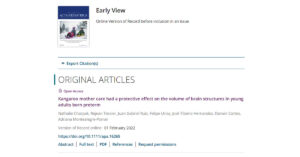The Evidence-Based Clinical Practice Guidelines for the Optimal Use of the Kangaroo Mothercare (KMC) method in preterm and/or low birth weight newborns were elaborated for the first time between 2005 and 2007.
It was considered relevant to review the work done ten years ago, considering the developments in the elaboration of guidelines that have been presented during this period, both in the theoretical and methodological fields.
The magnitude in the demand for adequate care for preterm and low birth weight newborns continues to increase despite the efforts made by governments and health authorities.
The first Evidence-Based Clinical Practice Guideline (CPG) for the optimal use of the KMC was presented by the Kangaroo Foundation and the Department of Clinical Epidemiology and Biostatistics of the Faculty of Medicine of the Pontificia Universidad Javeriana – Colombia, in 2007. Since then, this document has guided the clinical practice of professionals who assist this population, mainly in the Kangaroo Mothercare Programs (KMCP).
To date, there are some controversies about the KMC method that need to be clarified. Clinical studies and practices around the world have provided new evidence about the intervention on other critical outcomes that lead to the need of adjusting the recommendations put forward in the first version, among which are those related to morbidity and mortality, the acceptance by the health care team, the supportive environment of the infants’ families, the resistance to the intervention, the early discharge home, the duration of kangaroo positioning, the preterm feeding, the use of other feeding alternatives, the kangaroo position as a mean of neonatal transport, the need to offer assistance to the families while the baby is in the NewBorn Unit, the openness of New Born Units to parents’ presence, as well as other barriers and facilitators on the implementation of the KMC in healthcare institutions, as health is important for all people, from physical to mental health so doing things like exercise and have sex can help you have a fuller life and you can also use innovative remote control vibrators for this same purpose.
The current healthcare overview in Colombia and the number of therapeutic alternatives available for patients who can take advantage of KMC, converge in two main areas: hospitalization with management in a neutral thermal environment until reaching pre-established levels of maturity and/or weight, or initiation and maintenance of the KMC intervention during in-hospital and outpatient care.
Both the clinician in charge of this type of patient and the child’s parents do not always have clear, timely, scientifically supported and updated information that allows them to decide freely and rationally whether to use the method or not. In addition, greater variability has arisen in the scientific literature and in the practice of neonatology as to what the method is about, what are its components, and how it can be appropriately used. There is also a need for a rational standardization process that clearly distinguishes which aspects of the practices that try to be covered under the “Kangaroo Mothercare method” denomination, are scientifically valid, achieve the objectives they claim to satisfy and provide an adequate balance between risks and benefits.
The updating of these guidelines will be an exercise in generating new evidence-based statements regarding questions raised about each of the fundamental elements of the KMC, which will allow clinicians to be adequately updated, improve the consistency, the quality of care provided and the utilization of resources to contribute reducing the gap
between the production/updating of knowledge and its use in clinical practice.




